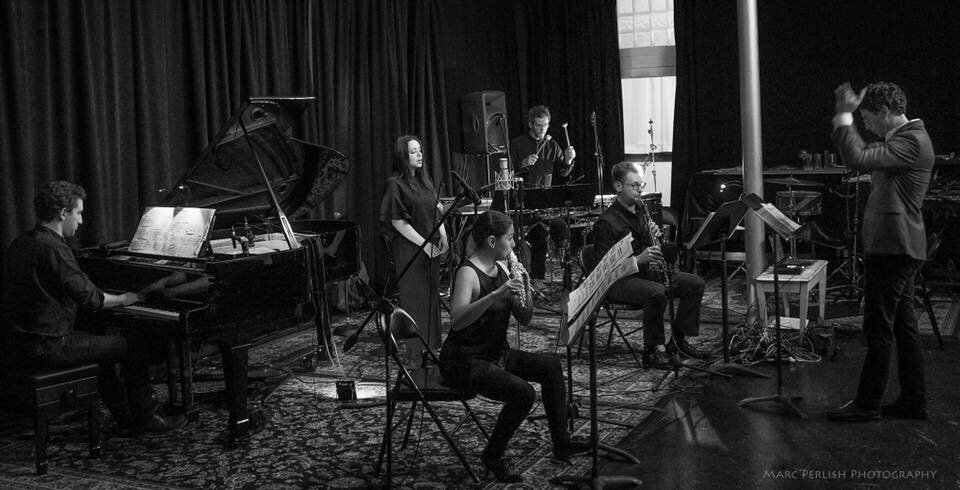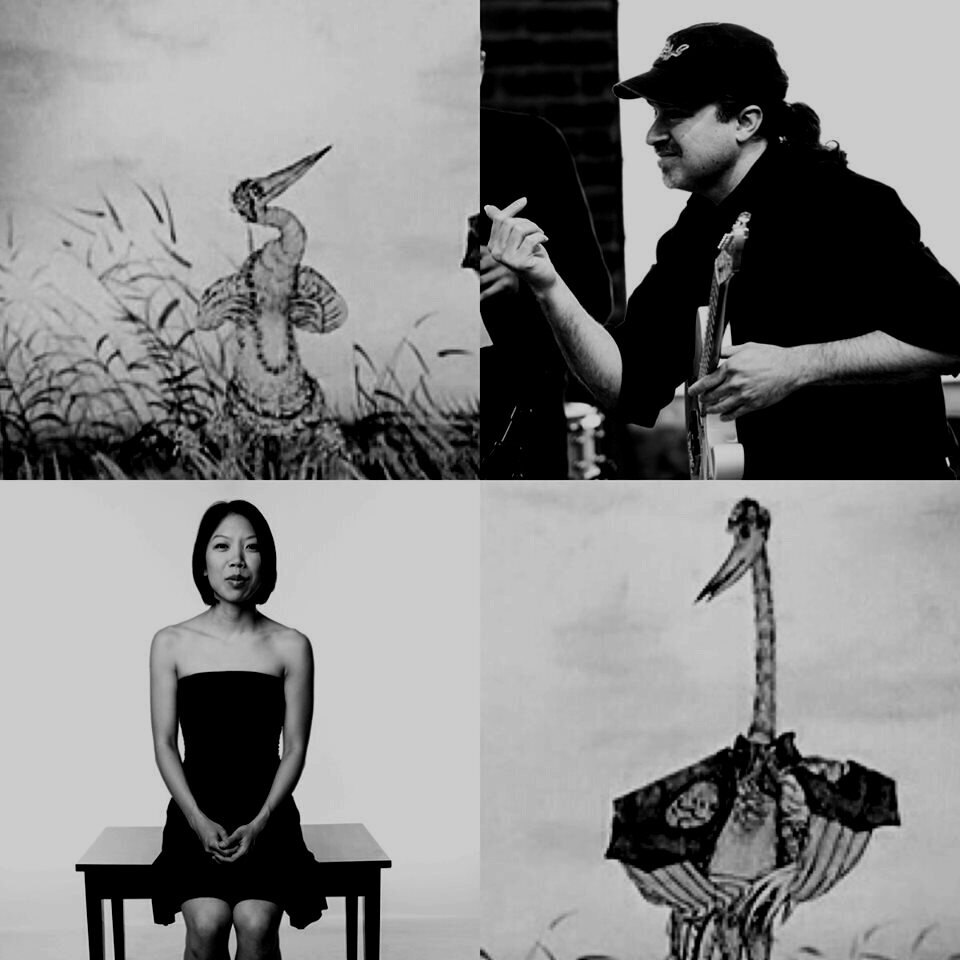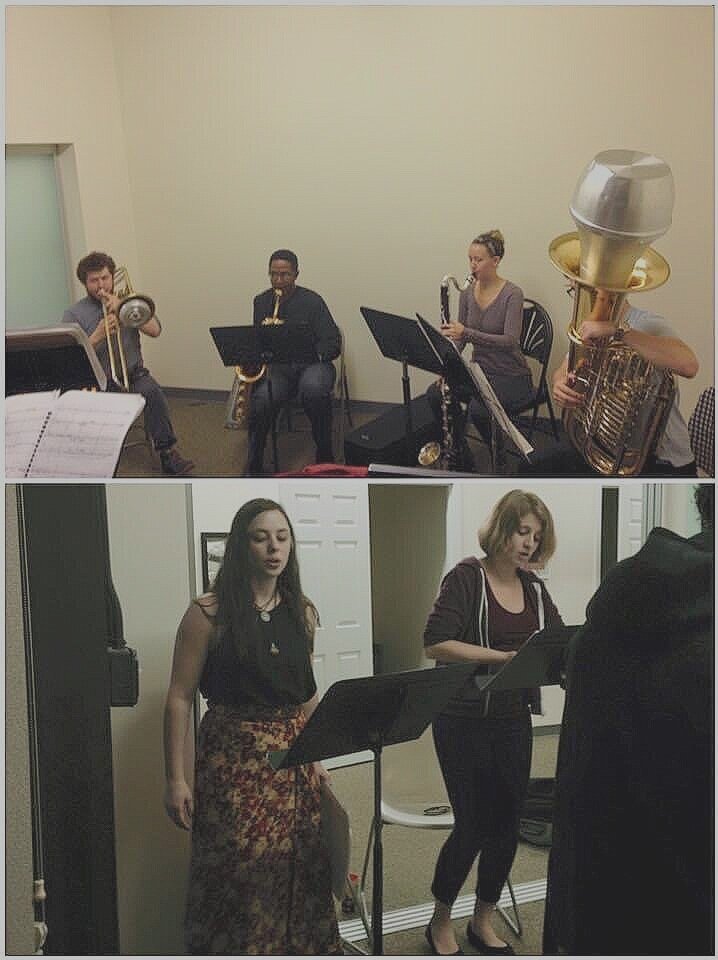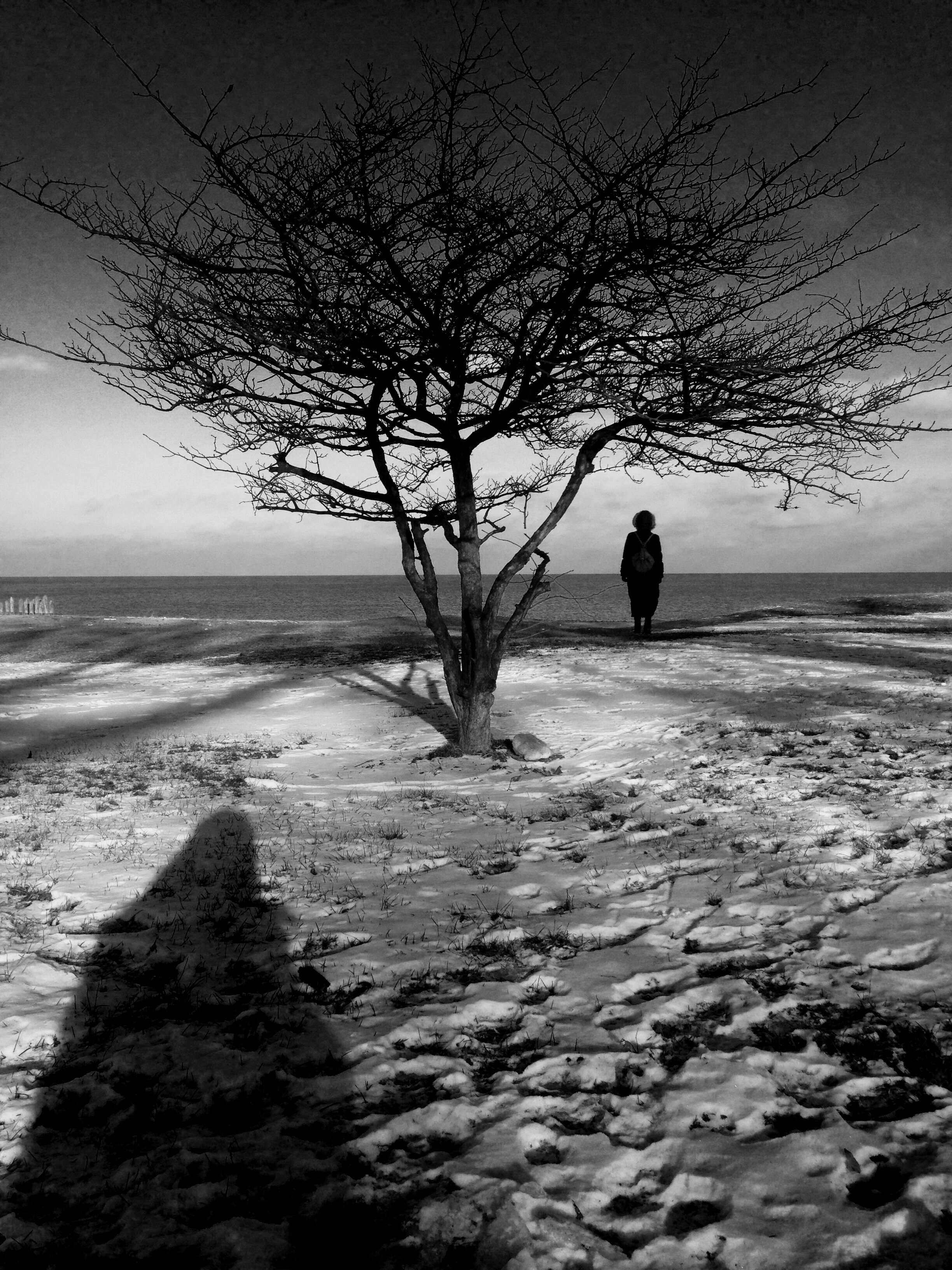
Listen
Ivory Tower 2024)
string trio and live electronics
This piece explores themes of protest and community building through intertextuality. It is inspired and modeled after Ecuadorian Mesias Maiguashca’s piece ...por el Yasuní… in which a violin and cello duo manipulate recordings of street protests against oil drilling in the Amazonas through live electronics. Similarly, in Ivory Tower the trio (violin, viola and cello) trigger snippets from the 2016 protests against DAPL at Standing Rock combined with sounds of Maiguashca’s piece. Sounds of drumming, singing or simply the environment will transition between foreground and background, or merge with the string trio. This piece attempts to establish a productive network between Maiguashca’s music and my own, in part as a homage to his music, but also as an expression of communal art, which is essential to political art.
Deprofundido II and III (2019)
Jesús Mozo, accordion
Ponferrada, Spain 10.18.19
The title makes reference to Sofia Gubaidulina’s De Profundis, also written for the Bayan, and the Spanish term “fundido,” meaning melted (as in fondue), but most precisely fused. Deprofundido III combines two streams of music in different tempi and character. The top system is a constant pulsing varying in speed and density, while the bottom system is a series of chords, that as in Gubaidulina’s ascends from the depths of the low register towards the altissimo notes. In addition to the solo version of Deprofundido III, a first version is composed for mixed media (virtual accordion), and a second one for mixed media and accordion. The virtual accordion is made of fused midi sounds, and in the case of Deprofundido II the sound of the virtual accordion incorporates combined non-tempered pitches in ways similar to sound synthesis, increasing the complexity of the timbre. Each version of Deprofundido can be programmed alone, or as the full set, never in pairs. If programmed as a full set, it is advised that each version of Deprofundido is interspersed by other pieces in the concert, always following the order I, II and III.
Deprodundido was composed for Jesús Mozo as part of the project CRBayan, showcasing new works for the instrument by Costa Rican composers.
Deprofundirse (2019)
saxophone quartet
The title makes reference to Chin’s preceding piece “Deprofundido” for accordion, which at the same time makes reference to Sofia Gubaidulina’s “De Profundis,” written for the same instrument, and the Spanish term “fundido,” meaning melted (as in fondue), but most precisely fused. “Deprofundirse” magnifies in volume and spatial possibilities its accordion version, and combines two streams of music in different tempi and character. Bass and baritone saxophones are constantly pulsing low tones in varying speeds and density, while tenor and alto saxophones perform a series of “screaming” multiphonics, that as in Gubaidulina’s piece ascend from the depths of the low register towards the altissimo notes.
Como la leyenda de Tlön (2013)
soprano and percussion
This piece consists of the enactment of of two poems by Nina Dante imagined after the fictional language of Borges’ planet Tlön in his Tlön, Uqbar, Orbis Tertius.
The following poem is comprised of two iterations of a text inspired by Borges’ imaginary world Tlön and its Ursprachee. The lone three words in the middle of the text serve as a hinge around which the iterations revolve. The first iteration is the manifestation of the northern dialect of Tlön’s Ursprache as I imagine it, in which nouns are represented by verbs; while the second is in the southern dialect in which nouns are represented by clusters of monosyllabic adjectives (this iteration is written word for word backward, a sort of mirror image of the first iteration with the significant grammatical changes above mentioned).
Sralán, Föl-xax
Sralán
Laó dö trilaöl nan lu fur röln
Fö hra jaslöth jaslúl mnámna
Jaslúl ap apapapál.
Ap u mjánae laó hupöl laóma trilaé
Trilaul nan lu gúlfang fö kxat,
Junúl daé ak kak
Lahrá mnarál imlúl ap únan öbma,
Thaóln pal
Úlulug pal
Hlaérna grak apdaé dahrá lu laharín xat örthul, xíthul, dörn daé öbma dörn ap apapapál ápa hröthar apáma phlaó úrmul un urm öp löf daé lu sahál jas hru pipulúl gal dalahrá mlöln söl sölax, mámdal, kxaél mnámna maltapát fö ujasú ip tálin ip xönír ip...
Irá...? Tianú...? Ápa...?
... ip pal-grá ip fás-tum ip srö-tum fö húp-hrön mnámna kxaél, mamdal, sölax söl srö-örs dalahrá gal pipulúl hru jas ak-mne lu daé löf öp pál-mlöx un urmul jás-tum apáma hröthar ápa uu-kálm ap dörn öbma daé dörn, xithul, örthul xat xu-hrön lu dahrá apdaé grak Fáng-gra
pal Uu-húp
pal Hríp-tap
öbma únan ap imlul mnarál xú-dörn Lahrá kak ak-ak daé Junul
mné-xax fö 'hlö-hup lu nan Trilaul
jás-aal laóma hupöl laó hlé-dörn u Ap uu-kálm ap Jaslul
mnámna jaslul pal-lín hra Fö grá-hup fur lu nan trilaöl dö Laó 'Föl-xax
Guitarra Muda II (2019)
soprano, recorder and bass
This is the second piece by Chin that sets to music poetry by Panamanian multidisciplinary artist Mar Alzamora-Rivera, based on a line “mute guitar” from her poem “August and Everything After” from 2016. In this piece the bass and flute alternate fully written passages with semi-improvised ones, intensifying instability while preserving fluidity. The voice on the contrary is modest and minimized.
Si Chavela met Matta cycle
(2018-19)
Si Chavela met Matta proposes a fictional situation in which the visual contours of Chilean painter Roberto Matta’s work blend with the a cappella voice of Chavela Vargas, born in Costa Rica and Mexican cultural icon. Recordings of Vargas and of various chord progressions were transformed through a granular synthesis computer application. Following the contours of Matta’s painting “Le coeur de loeil,” the cursor draws over the sound files, slowing them down, speeding them up, freezing and reverting them, or raising and lowering their pitch. The resulting audios were transcribed to musical notation and adapted to the possibilities of each instrument and instrumental combination.
As a solo vocal work this piece was composed for Nina Dante and the Resonant Bodies Festival. As a trio for voice, percussion and piano, for Fonema Consort. The trio and octet version was composed for the Orquesta Sinfónica de Heredia (OSH).
Guitarra Muda I (2018)
narrator, clarinet, vln, vla, cello and bass
This piece sets to music poetry by Panamanian multidisciplinary artist Mar Alzamora-Rivera, based on a line “mute guitar” from her poem “August and Everything After” from 2016. It was composed as a collaboration while at a residency at Casa del Soldado in Panama City with support from the foundation Ibermúsicas. In this version the voice is recited over densely woven textures by a quartet of violin, viola, cello and bass, while a clarinet playing at times with half the body of the instrument, or the full instrument, with mouthpiece or without it, embodies the different meanings evoked in the poem.
Music for the Heron and the Crane (2014)
piano/harpsichord and guitar
Music for the Heron and the Crane is based on the animated film The Heron and the Crane by Russian filmmaker Yuri Norstein. Its scattered, fragmented design derives from the visual alternation of the characters in the film, which causes a constant shifting of focus from one character to the other. There is an evident attempt at exploring the shaping of musical characters in each of the 29 fragments in the piece. Therefore, an effort must be made to bring out these identities without necessarily connecting them with each other, as would be the case in a cause-and-effect unfolding of events.
(in)armonia: The Sirens Song (2016)
sopr, mezzo, bass cl, bar sax, tbn and tuba
This piece is the first of four scenes in a future opera depicting the driving forces that motivate the artist to create. These forces, often defined as “inspiration” are embodied in my opera in- progress by supernatural characters, like sirens, ghosts, muses and witches. In the case of this scene, the vocal parts are musical settings of the songs of the sirens to Ulysses in Homer’s The Odyssey. During this episode of Odysseus' epic journey sailing back home after the Trojan wars, he commands his crew to block their ears to avoid falling enchanted by the sirens’ song meant to attract them to jagged rocks and imminent death. He, however is tied to the mast of the ship with his ears open to witness the mysterious deadly chants. The raging waters can be related to the low sounds of bass clarinet, baritone saxophone, trombone and tuba, while the sirens are represented by soprano and mezzo-soprano.
This piece was composed to be premiered at the Ear Taxi Festival, Chicago, October of 2016
The piece is dedicated to Fonema Consort
(in)armonia: mythologies (2015)
sopr, e-flat cl and viola
This piece sets to music scenes by the witches of Shakespeare’s “Macbeth.” Scored for soprano, E-flat clarinet and viola, each movement revisits in idiosyncratic ways classical forms. The first one may resemble a rondo form in which the only synchronized pages of the score become the refrain. This refrain starts as an incomplete fragment and is gradually extended with each repetition until fully performed in the last iteration. The episodes are games in which the players begin and end at different places of an apparently synchronized score, thus heightening performance independency. The second movement may be compared to a cannon, in which the imitation is achieved by changing tempi independently in each part, in a score that as the first movement is apparently synchronized. The last movement revisits theme and variations, alternating similarly designed tableaus but always reassigning the players’ roles, forcing the music to adapt to the capability of each instrument.
Como la leyenda de Ixquiq (2009)
flute duo
According to the Popol Vuh (the sacred book of the Quiché Indians of Mesoamérica), Hun-Hunahpú had been turned into a tree by the Sirs of Xibalbá (the underworld). When young maiden Ixquiq, out of curiosity, descended to the underworld to grab the precious fruits of the mythical tree, Hun-Hunahpú spited into the palm of her right hand. His saliva contained his descendants. And that is how legendary heros Hunahpú and Ixbalanqué were conceived.
Like in the legend of Ixquiq, this piece was born out of the “saliva” of three notes: a C-Sharp, G, and F-pizzicato.
This piece was written for Claire Chase and Eric Lamb.
Como la leyenda de la Gran Muralla China (2009)
tenor and baritone saxophones
“The Great Wall of China was finished off at its northern-most corner. From the southeast and the southwest it came up in two sections that finally converged there. This principle of piece-meal construction was also applied on a smaller scale by both of the two great armies of labor, the eastern and the western. It was done in this way: gangs of some twenty workers were formed who had to accomplish a length, say, of five hundred yards of wall, while a similar gang built another stretch of the same length to meet the first. But after the junction had been made the construction of the wall was not carried on from the point, let us say, where this thousand yards ended; instead the two groups of workers were transferred to begin building again in quite different neighborhoods. Naturally in this way many great gaps were left, which were only filled in gradually and bit by bit, some indeed, not till after the official announcement that the wall was finished. In fact it is said that there are gaps which have never been filled in at all, an assertion, however, that is probably merely one of the many legends to which the building of the wall gave rise, and which cannot be verified, at least by any single man with his own eyes and judgment, on account of the extent of the structure.”
From The Great Wall of China, by Franz Kafka
From Afar (2014)
trombone, optional 2 female voices and tape
From Afar tests the crossing paths between the phonetic qualities of the human voice and the performance practice of musical instruments. In this piece, the recording of a low female voice reciting a verse by Ungaretti cited in Cortázar’s chapter 42 of Hopscotch, is subjected to minor processes (extraction of overtones and time stretching) that render melodic lines rich in subtle glissandi, thus suitable for the trombone. The sound samples were further transformed after being transcribed to musical notation, and the results served as the basis to the piece. The expression resulting from the dichotomy voice/instrument, finds additional poetics in the use of practice mutes and amplification, giving the piece an ethereal but palpable character.
Three Burials (2015)
solo flute, cello, bass, piano and guitar
Three Burials departs from the conjoining, intersection, overlapping and coexistence of musical and visual materials alluding to death and burials. Three movements can be accompanied by the screening of two burial scenes, one from the 1936 film Redes (The Wave) originally scored by Silvestre Revueltas, and the other from Sergei Eisenstein’s “Qué viva México,” and a third scene alluding to a funeral within a dream from Irgman Bergman’s “Wild Strawberries.” The piece uses two versions of the same solo flute part (this could be a reference to Ferneyhough’s “Funerailles”) as pillars framing a middle movement featuring a succession of 71 microtonal clusters (a reference to Haneke’s 71 Fragments of a Chronology of Chance?). Fragments from the flute solos function as guideposts for the cellist and bassist to semi-improvise dynamics, rhythmic articulation and bow colors throughout this movement. In the first movement the flute plays against an independent ensemble piece, and in the third movement the ensemble only intervenes half way into the solo flute to cite my own piece Music for the Hedgehog in the Fog and a superimposed citation from Ravel’s Pavane pour une infante défunte replacing the original citation from his Ma mere l’oye in my cited piece.
This piece was commissioned by my sister Dalia Chin to whom it is dedicated with warmness and admiration.
The premiere of Three Burials is made possible with major support from a City of Chicago DCASE grant and is given by members of Ensemble Dal Niente and conductor David Cubek
De mi memoria fluye lo que tu llamas belleza (2009)
solo piano
The title of this piece, as that of its sibling work for cello De mi canto fluyen soledades ajenas paraphrase an orchestral work by Toru Takemitsu From me flows what you call time. The title inspires a meditative and retrospective mood, and the opening flute solo in Takemitsu’s piece also informs certain harmonies in this piece. This piece does not mean to claim what beauty should be in music but beauty is rather an allegory. The opening repeated descending notes are later transformed into memories scattered throughout more pointillistic textures in the second half of the piece.
Seven Studies on Chapter 34 (2012)
solo female voice and tape
The inventiveness, the obscure places of the imagination, the sincere and the absurd fascinate me in the literature of Julio Cortázar. This is my fourth piece that is influenced (directly or indirectly) by his works, in this case, chapter 34 of his novel Rayuela (Hopscoth), in which two texts are overlaid in alternating lines, one quoting fragments of the other. Those fragments provide the textual material on which the songs are based. Each movement is an exploration on Spanish words and phonetics, and on vocal techniques. The tape showcases the principal text, narrated by the main character, Oliveira. Minimal processing was applied to the recordings of Argentinean actress Cruz González Cadel, consisting mainly of delays and panning.
The piece can be performed without the tape.
This piece is written and dedicated with much affection to Nina Dante.
In the Form of a Shell (2013)
solo flute and orchestra
In the Form of a Shell derives most of its musical material from Canto y danza de los innúmeros abuelos for solo clarinet, by my former mentor Alejandro Cardona, to whom this piece expresses my admiration and gratitude. The piece contrasts and superimposes two different ways of exploring multiplicity of musical streams: one very hectic and contained, in the soloist part; and the other dilated and spatial, embodied by the orchestra.
This piece was generously commissioned by Scripps College for the Claremont Concert Orchestra and their conductor David Cubek.
In its chamber orchestra version in this recording, it is dedicated to the Orquesta Sinfónica de Heredia.
Persona, bass ver. (2013)
double bass
This piece was commissioned by cellist Katinka Kleijn for the Chicago Humanities Festival of 2010. It was adapted to bass for Kathryn Schulmeister. It is inspired by the repeated scene of Ingmar Bergman's film Persona. Both versions of the scene show a still close-up of one of the two characters, one speaking, the other listening. The inflections of the Swedish language informs the quarter-tone inflections of the melodic lines, while the harmonics and timbral changes are fantasies on coloring the black and white film.
Persona, cello ver. (2010)
cello
This piece was commissioned by cellist Katinka Kleijn for the Chicago Humanities Festival of 2010. It is inspired by the repeated scene of Ingmar Bergman's film Persona. Both versions of the scene show a still close-up of one of the two characters, one speaking, the other listening. The inflections of the Swedish language informs the quarter-tone inflections of the melodic lines, while the harmonics and timbral changes are fantasies on coloring the black and white film.
For Instance Mozart (2010)
a-clarinet and cello
For Instance Mozart is part of an ongoing project consisting of pieces based on materials extracted from my piece for small ensemble, After Pehuajó (2010). In this case, the material consists of a texture made of short elaborate pulses of different lengths, which in this new context embodies the resonances left by the gestures in the opening section: strong attacks in the highest register decaying into the low register, at which point these resonances take over. Later, the resonances reconstitute into melodic lines that counterpoint each other. While composing the last section of this piece, I wanted a distorted theme from the clarinet repertoire to emerge from the cello’s sustained ascending line; for instance, the Adagio from Mozart’s concerto k. 622. In this search for that theme, the cello line encounters the two opening bars of Mozart’s accompaniment (also distorted), now the closing bars in this piece.
For Instance Mozart was commissioned by the MAVerick Ensemble, and is dedicated to Andrea DiOrio and Jason Raynovich.
Sólo es real la niebla (2011)
soprano, flute and sopr. saxophone
Mis pasos en esta calle Resuenan
en otra calle
donde
oigo mis pasos
pasar en esta calle donde
Sólo es real la niebla.
by Octavio Paz
Retrato del Gran Pájaro Feo (2011)
violin and tape
Against a constant background of white noise (inspired by the maracas in Murail’s Ethers), a violin soliloquy emerges. The background originates from a recording of the rainforest of Tortuguero, on the Caribbean coast of Costa Rica. During digital processing, the Montezuma oropendola, a bird of robust and sublime song, was erased from the sources. Its song was replaced with the rusty gestures of the violin, which permeate the entire piece. Such is the temperament of the “Gran Pájaro Feo”, a magical creature dreamt by Nina Dante, that, imperfect like Prometheus, sacrifices himself for earthly life throughout his yearly journeys to the depths of the ocean.
This piece is dedicated to Austin Wulliman.
The original nature sounds were recorded by film and television designer Andrew Roth.
After Pehaujó (2010)
chamber ensemble
After Pehuajó consists of eleven compartments, each of which introduces one or more new filters to the original material, or simply new material. Pauses or breaks occur sometimes between compartments, or within them. This causes a further fragmentation of the whole. The longest pause seems to divide the piece in two larger blocks, the second being an attempt to recompose the first. In fact, the chaotic and diffuse character of the piece is mostly due to the several attempts to recompose (perhaps more successfully) what has been previously stated. During the piece, long lines undergo processes of decomposition, from which the leftovers are recycle, so as to produce new events.
This piece was inspired by the theater play Nada a Pehuajó by Julio Cortázar.
Echos of the Steppenwolf (2006)
chamber ensemble
Composed for the International Contemporary Ensemble (ICE) this piece was inspired by Hermann Hesse’s novel Steppenwolf. More concretely, the passion of the main character for The Magic Flute triggered the repeated notes that open the piece, just as in Mozart’s overture, and from there it goes its own way.
De mi canto fluyen soledades ajenas (2009)
cello
De mi canto, que brota y se propaga por espacios insípidos, fluyen soledades ajenas (From my song, that blossoms and propagates through insipid spaces, foreign solitudes flow)
Composed for Lucas Fells.
Rojo sobre Blanco (2009)
quasi solo oboe and chamber ensemble
Like a distant sun at dusk, lightly reddening the horizon but also yielding to the embracing white;
like traces of fresh blood on the snow, still warm and alive, covered and uncovered by indifferent playful winds;
like a tiny, fragile, red bird, singing his solitude on top of woven weary branches, a song lost on the transparent silence of the ice; like the penetrating voice of an oboe, at last emerging from colorless resonances of a small ensemble.
Music for the Hedgehog in the Fog (2012)
eleven instruments
This piece is inspired by a Russian animated film entitled “The Hedgehog in the Fog”. I was fascinated by the visual textures, and the idea of all the creatures and objects in the forest popping-up to the Hedgehog out of the mystery of the embracing fog. I could not help to imagine the sonic analogy to it. Therefore, I envisioned a continuous texture made of “breathy” sounds (air sounds in the winds, rubbing sounds in the percussion and piano, and muffled sounds in the strings), out of which musical objects (rhythmic figures, chords, quotations) would emerge.
Literature is always a source of inspiration for me, after music itself of course. I identify a lot with magic and fantasy in literature, like in Borges or Cortázar. In the case of the “Hedgehog”, it triggers images or sensations of childhood, and made me think of works like the “Little Prince”, or Ravel’s “Ma mere l’oye”. Music material has been in fact derived from the latter, in the form of harmonic structure, chords and short motivic quotations.
This piece was commissioned by Ensemble Dal Niente
Premiere: 46th Internationale Ferienkurse für Neue Musik, 2012, Darmstadt, Germany.
The piece is dedicated to Ensemble Dal Niente.
Twelve Journeys of the Gran Pájaro Feo I, II, III (2011)
string trio
“Today while I was walking up the stairs, I imagined a giant mountain at the very top of which grows a little white flower with the center like an eye and the edges of the petals stained red. I think it would have to have magical properties, or maybe is picked once every thousand years by someone who needs a desperate wish to be fulfilled. The seed was carried there in the beak of a forgotten species of bird, which has the ability to dive deep into the ocean, to the very bottom of the ocean where the seed is born. Once the flower is plucked, it turns to red stone and then crumbles to dust, and the bird must once again dive into the ocean and fly with a new seed to the mountain. The universe cannot exist without the flower on top of the mountain because everything is connected.”
Nina Dante






























